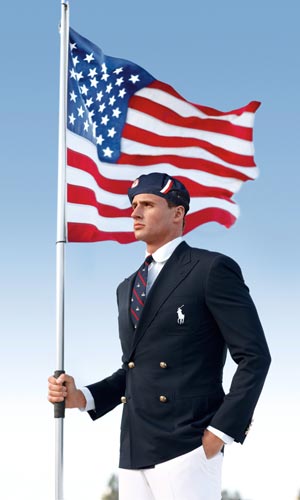
This image released by designer Ralph Lauren shows a US Olympic athlete modeling the official Team USA opening ceremony parade uniform that was made in China. [Photo/Agencies]
As a controversy about the "Made in China" uniforms for members of the US Olympic team continued to erupt, one US track and field Olympian expressed his thanks to China.
|
 |
|
This image released by designer Ralph Lauren shows a US Olympic athlete modeling the official Team USA opening ceremony parade uniform that was made in China. [Photo/Agencies] |
The uniforms for the opening ceremony are American red, white and blue. The berets, blazers and pants were designed by US label Ralph Lauren and made in China.
When ABC News reported the facts, the story sparked more than 6,500 comments on Yahoo News, where the reaction was mixed.
However, on Thursday, Republicans and Democrats railed against the US Olympic Committee's decision to dress the US team in Chinese-manufactured uniforms.
"I am so upset. I think the Olympic committee should be ashamed of themselves. I think they should be embarrassed," Senate Majority Leader Harry Reid told reporters at a Capitol Hill news conference.
"I think they should take all the uniforms, put them in a big pile and burn them, and start all over again."
House Democratic Leader Nancy Pelosi told reporters at her weekly news conference that she's proud of the US' Olympic athletes, but "they should be wearing uniforms that are made in America".
The committee defended their choice of manufacturers by sharing that they are privately funded and so rely on sponsorships for clothing and equipment.
"Unlike most Olympic teams around the world, the US Olympic team is privately funded and we're grateful for the support of our sponsors," committee spokesman Patrick Sandusky said in a statement.
"We're proud of our partnership with Ralph Lauren, an iconic American company, and excited to watch America's finest athletes compete at the upcoming Games in London."
On Twitter, Sandusky called the outrage over the made-in-China uniforms nonsense.
Ralph Lauren declined to comment on the criticism.
In fact, if anyone has something to be upset about, it's China, said the New York-based Brandchannel.com, noting that Nike, a US brand, unveiled uniforms for China's Olympic team for the London Games in June.
"Made in China" is a phrase US citizens know mainly as an indicator of pervasive offshore manufacturing. But increasingly it's being attached to products originating in China from US companies - and gaining acceptance in the West.
A recent survey by Li Ning Co Ltd, a leading Chinese athletic footwear and apparel company, found that a growing number of consumers in the US are willing to buy products of Chinese origin.
Two consumer groups, those aged 18 to 25 and those with annual household incomes of more than $225,000, were most likely to regard Chinese brands favorably.
More than half of the survey respondents, according to Li Ning Co Ltd, said they believe the quality of Chinese brands will measure up to US-branded goods in the next five years.
It's impossible for US citizens to completely stop using Chinese-manufactured goods, given the irreversible trend of globalization and increasing economic interdependency between the two sides, said Dong Manyuan, deputy director of the China Institute of International Studies.
Before a presidential election, Republicans and Democrats are accustomed to accusing China of taking US jobs, in order to lobby voters and divert attention from the country's own problems," he said. "But once elected, almost every president will conduct normal exchanges and practical cooperation with China," he added.
Many US fashion brands have survived by getting rid of high costs created by the labor-intensive textile industry and moving their production lines to Chinese factories with intensive, cheap labor.
According to the China National Textile and Apparel Council, China's textile and garment exports to the US, the European Union and Japan dropped 6.55 percent in the first quarter.
Contact the writers at chenjia@chinadailyusa.com and zhaoshengnan@chinadaily.com.cn.